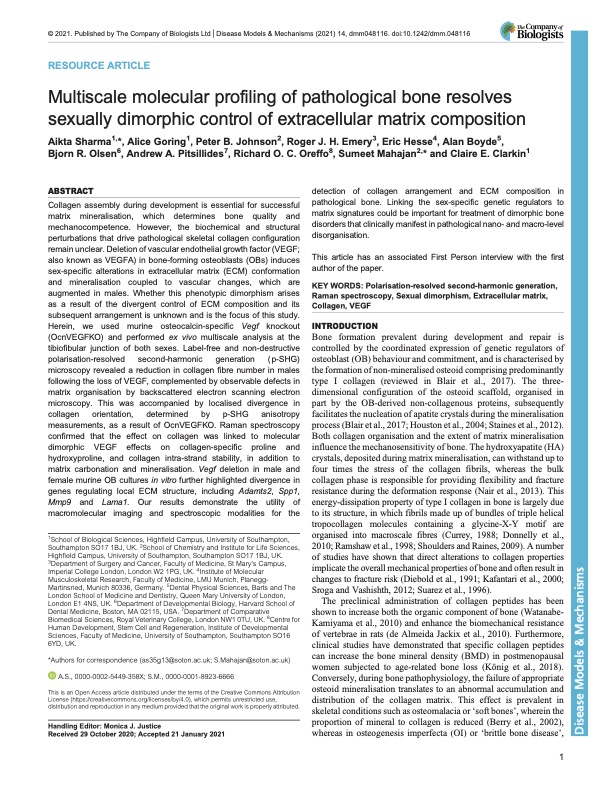A Sharma
Multiscale molecular profiling of pathological bone resolves sexually dimorphic control of extracellular matrix composition
Sharma, A; Goring, A; Johnson, PB; Emery, RJH; Hesse, E; Boyde, A; Olsen, BR; Pitsillides, AA; Oreffo, ROC; Mahajan, S; Clarkin, CE
Authors
A Goring
PB Johnson
RJH Emery
E Hesse
A Boyde
BR Olsen
AA Pitsillides
ROC Oreffo
S Mahajan
CE Clarkin
Abstract
Collagen assembly during development is essential for successful matrix mineralisation, which determines bone quality and mechanocompetence. However, the biochemical and structural perturbations that drive pathological skeletal collagen configuration remain unclear. Deletion of vascular endothelial growth factor (VEGF; also known as VEGFA) in bone-forming osteoblasts (OBs) induces sex-specific alterations in extracellular matrix (ECM) conformation and mineralisation coupled to vascular changes, which are augmented in males. Whether this phenotypic dimorphism arises as a result of the divergent control of ECM composition and its subsequent arrangement is unknown and is the focus of this study. Herein, we used murine osteocalcin-specific Vegf knockout (OcnVEGFKO) and performed ex vivo multiscale analysis at the tibiofibular junction of both sexes. Label-free and non-destructive polarisation-resolved second-harmonic generation ( p-SHG) microscopy revealed a reduction in collagen fibre number in males following the loss of VEGF, complemented by observable defects in matrix organisation by backscattered electron scanning electron microscopy. This was accompanied by localised divergence in collagen orientation, determined by p-SHG anisotropy measurements, as a result of OcnVEGFKO. Raman spectroscopy confirmed that the effect on collagen was linked to molecular dimorphic VEGF effects on collagen-specific proline and hydroxyproline, and collagen intra-strand stability, in addition to matrix carbonation and mineralisation. Vegf deletion in male and female murine OB cultures in vitro further highlighted divergence in genes regulating local ECM structure, including Adamts2, Spp1, Mmp9 and Lama1. Our results demonstrate the utility of macromolecular imaging and spectroscopic modalities for the detection of collagen arrangement and ECM composition in pathological bone. Linking the sex-specific genetic regulators to matrix signatures could be important for treatment of dimorphic bone disorders that clinically manifest in pathological nano- and macro-level disorganisation. This article has an associated First Person interview with the first author of the paper.
Citation
Sharma, A., Goring, A., Johnson, P., Emery, R., Hesse, E., Boyde, A., Olsen, B., Pitsillides, A., Oreffo, R., Mahajan, S., & Clarkin, C. (2021). Multiscale molecular profiling of pathological bone resolves sexually dimorphic control of extracellular matrix composition. Disease Models and Mechanisms, 14(3), https://doi.org/10.1242/dmm.048116
| Journal Article Type | Article |
|---|---|
| Acceptance Date | Jan 21, 2021 |
| Publication Date | 2021 |
| Deposit Date | Jan 6, 2022 |
| Publicly Available Date | Jan 6, 2022 |
| Journal | Disease Models and Mechanisms |
| Print ISSN | 1754-8403 |
| Electronic ISSN | 1754-8411 |
| Publisher | The Company of Biologists |
| Peer Reviewed | Peer Reviewed |
| Volume | 14 |
| Issue | 3 |
| DOI | https://doi.org/10.1242/dmm.048116 |
| Keywords | Polarisation-resolved second-harmonic generation; Raman spectroscopy; Sexual dimorphism; Extracellular matrix; Collagen; VEGF; COLLAGEN FIBER ORIENTATION; 2ND-HARMONIC GENERATION; CORTICAL BONE; OSTEOBLAST DIFFERENTIATION; MECHANICAL-PROPERTIES; ANDROGEN RECEPTOR; FIBROUS DYSPLASIA; MINERALIZATION; OSTEOGENESIS; SKIN |
| Public URL | https://rvc-repository.worktribe.com/output/1554536 |
Files
OA
(219 Kb)
Image
Publisher Licence URL
http://creativecommons.org/licenses/by/4.0/
You might also like
Expression of semaphorin-3A in the joint and role in osteoarthritis
(2024)
Journal Article
Bone marrow lesions: plugging the holes in our knowledge using animal models
(2023)
Journal Article
Downloadable Citations
About RVC Repository
Administrator e-mail: publicationsrepos@rvc.ac.uk
This application uses the following open-source libraries:
SheetJS Community Edition
Apache License Version 2.0 (http://www.apache.org/licenses/)
PDF.js
Apache License Version 2.0 (http://www.apache.org/licenses/)
Font Awesome
SIL OFL 1.1 (http://scripts.sil.org/OFL)
MIT License (http://opensource.org/licenses/mit-license.html)
CC BY 3.0 ( http://creativecommons.org/licenses/by/3.0/)
Powered by Worktribe © 2025
Advanced Search

